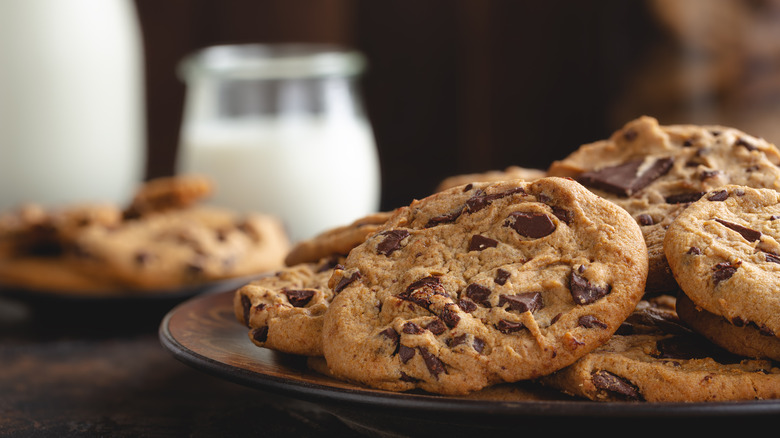The Ingredient Substitutes Used For Chocolate Chip Cookies During WW2 Rationing
The sacrifices of World War 2 touched lives around the world. While the toll for many was decidedly more grave than for others, the reach unfolded into nearly all aspects of life. On the homefront, rationing was the order of the day as various foodstuffs needed to be prioritized for the war effort. Difficult though it was, cooks were creative with the workarounds they devised to produce favored recipes within the confines of the rules.
Chocolate chip cookies are considered an American staple, one that was an instant hit upon its creation by Ruth Wakefield at the Toll House restaurant in the late 1930s. Only a few years later, with the nation plunged into war, cooks were looking for ways to recreate chocolate chip cookies and other sweets at a time when sugar and butter were among the scarce foodstuffs. Nestlé, the company whose chocolate was the original Toll House cookie, offered solutions as it had products to move and was cannily positioning chocolate chip cookies as a patriotic treat to send soldiers. In the place of butter, shortening — hydrogenated vegetable oil — was used to offer richness and mouthfeel. Sugar was actually swapped out for two different ingredients. In equal parts, strained honey — that is honey that has had most bits of particulate, such as comb and propolis, removed from it — and maple syrup were employed for sweetness.
Substitutions changed flavors and led to creativity
As anyone with baking experience can probably assume, these WWII cookies were not exactly the same as the original recipe Mrs. Wakefield created. For one, shortening, while rich and oily, has different properties than butter, namely it is far less flavorful as it lacks milk solids. Shortening also has a higher melting point than butter, so cookies made with shortening tend to spread less while baking. That last part is negated, though, by the sweeteners used. Honey and maple syrup have far more moisture than sugar and make for a cookie dough that is runnier and more prone to evening out while it cooks. What's more, the maple syrup adds a note of flavor not seen in other pre- and post-war chocolate chip cookie recipes.
Of course, chocolate chip cookies weren't the only sweet treat Americans craved during the war. In fact, people really just craved some sense of normalcy, and creativity was able to service those desires in some unexpected ways. Butter was in short supply, it's true, so what if you could double your supply? The Knox Gelatin company offered up a recipe for a sort of spread that employed a quarter pound of butter, a teaspoon of gelatin, a bit of salt, water, and fresh or evaporated milk. Reviews, sadly, are nonexistent, but one can surmise the Knox Spread was only intended for use atop, say, toast, as frying, sauteing, and even greasing pans with it is not recommended.

